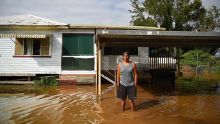Luana Campione's struggle is familiar to hundreds of thousands of households across NSW: the scramble to patch together childcare to fit around work, school drop-offs and pick-ups.
"You feel like you're not doing anything right," she says. "You have to leave work early to get the kids, you come home stressed, you work at night, trying to juggle everything. It's really tough.
More National News Videos
We're backing families: PM
The Turnbull government is celebrating the passage of its childcare changes through the Senate, saying it's a win for parents who want to get back into the workforce. Courtesy ABC News 24.
"School ends at 3, so you don't know what to do if you work. People who don't have family support are having to do whatever they can."
Ms Campione's daily battle is mirrored across the city, where there are severe shortages of before and after school care places driven by Sydney's booming school age population and the rise in dual-income families.

More than 22 per cent of out of school hours care providers report waiting lists of more than 20 families; 5 per cent have more than 40 waiting. At some schools in the inner west, kindergarten families could not get any after school care at their school this term.
Compounding the problem, no one is in charge: the Department of Education does not keep centralised figures on OSHC places or waitlists, leaving it up to individual schools and private providers to manage demand.
According to Robyn Monro Miller from the Network of Community Activities, the peak body for OSHC services, the shortage is worst in the inner west, the east and inner city, the Hills district, and North Sydney (which includes Ryde and the lower north shore).
But she said some schools are much worse than others, and regional areas like Newcastle and Wagga are under pressure too.
It's that much harder where Ms Campione's daughter Zoey goes to school in Leichhardt, where OSHC places are so short the former mayor Darcy Byrne says it is an "acute crisis".
At the beginning of the year when her daughter started kindergarten, Ms Campione could only secure one day of out of school hours care for her.
With her son Gianluca in daycare in Leichhardt, and her husband's job in Parramatta, Ms Campione was fortunate enough to have a boss who has allowed her to work flexibly and shift her work around.
She has picked up a couple more days over the course of the term, but still not Wednesdays, which she needs. "Wednesday it's impossible to get anywhere!" she says. "It's a very common problem, there's a real need."
Last year the Inner West Council opened town halls and community centres to offer 75 new OSHC places, but they were quickly filled, and now the waitlist is as long as it was a year ago.
New figures gathered by the council show there are another 300 families on waitlists in the council area. The shortage is worst at Leichhardt Public, where there are 112 families on the waiting list, and 180 enrolments.
At Rozelle Public there are 60 families unable to get after school care, with 255 already enrolled.
And Annandale North has 50 families on the waitlist for 120 places.
Survey data gathered by the peak body this week from 10 per cent of the state's 1450 OSHC service providers indicated 20 per cent were booked out every day, while 22 per cent had more than 20 families waiting for a place. Five per cent had more than 40 families on their waitlists.
Ms Monro Miller said that the dramatic boom in school enrolments due to population growth was having a big impact, with one quarter of NSW children accessing OSHC services on a weekly basis.
"We are finding that schools are filled to capacity and so opportunities for space for additional OSHC places then also become limited – it is a catch-22," she said.
OSHC services wishing to expand must meet national regulations for 3.25 square metres of indoor space per child and 7.5 square metres of outdoor space, which is impossible for many inner-city schools. OSHC services must also compete for space with after school extracurricular activities such as music or sport.
Mr Byrne said that overcrowding in local schools from "the state's biggest baby boom" was driving the problem, and blamed the state government for its "head-in-the-sand approach".
"With more than 100 students at Leichhardt Public on the waitlist the brutal truth is that kids entering kindergarten now may not have access to after school care for years to come," he said.
"Gladys Berejiklian and Rob Stokes must act to provide more places right now. They need to understand that for inner-west families paying enormous housing costs, after school care is not a luxury but a necessity."
A spokeswoman for the Department of Education, which regulates OSHC services, said the government did not run services but had established a $20 million grant fund to help create new OSHC places.
Home-based services for after school care, similar to family day care, have begun springing up to meet demand in the northern beaches and inner west.
However Ms Monro Miller said OSHC services would not be able to solve the problem alone and employers must step up to provide flexibility to families.
"We do warn the solution is not about necessarily establishing more services, but consolidating the current services and expanding to meet the demand. Workforce flexibility for families plus the recruitment and retention of OSHC educators are also issues that need addressing."















